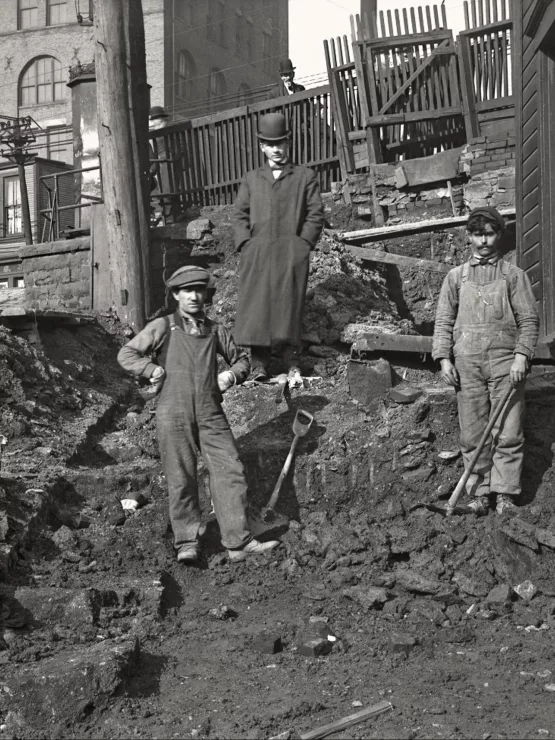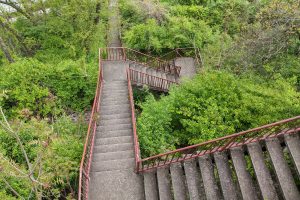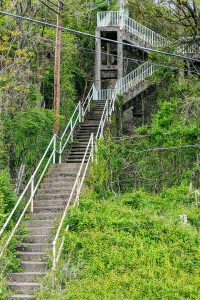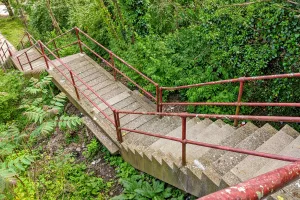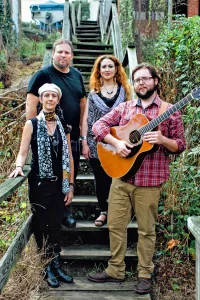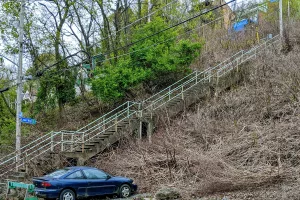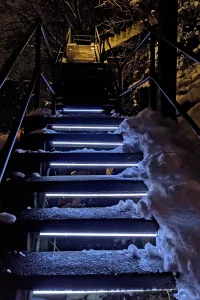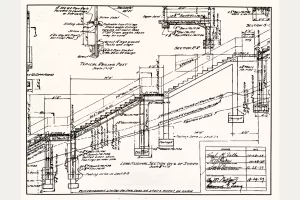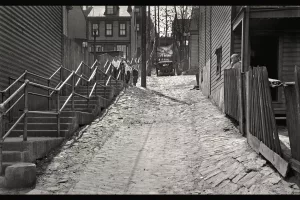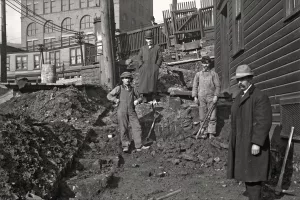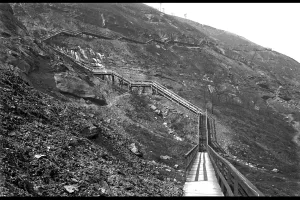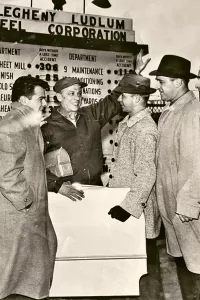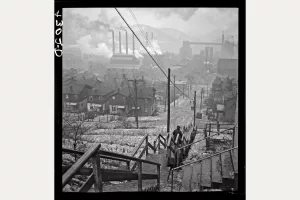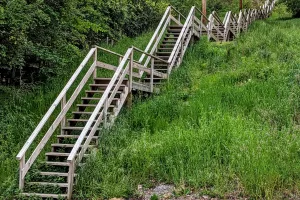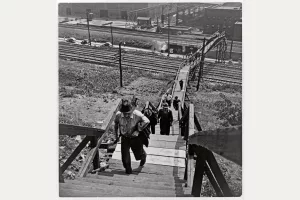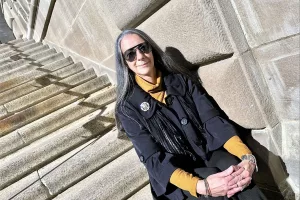Steps and steam hammers. Steps and polio. The Titanic. Porky Chedwick, and the World Series. These are a few associations Pittsburghers made when recalling their memories for my article, “Stepping through History on Pittsburgh’s Public Stairways” in the Fall 2022 issue of Western Pennsylvania History Magazine.
All the Pittsburgh area natives I interviewed have their own fascinating stories to tell. Darryl Gaines, a fitness instructor and trainer, says he climbed steps in the North Side down to Latimer Junior High and back every day. He regards these steps and others in the city as his training ground, thinking nothing of climbing from one hill to another, such as from Fineview to Mount Washington. Now he effortlessly scales steps in New York City, Los Angeles, and elsewhere.
“It all goes back to our city’s hills. Anytime I need to snap into shape, I go back to Pittsburgh. It’s the best workout city in the world,” he says. And what did he learn from climbing steps and biking rather than driving?’ “Pittsburgh taught me that my legs are my biggest resource,” Gaines said.
With some 800 public stairways, according to a City Planning Department tally, Pittsburgh has more steps than any other city in the country. The earliest public stairways were built between the late 1800s and early 1900s. They were the first form of public transportation for the steel workers who lived in the hills to commute down to the mill in the valley and back each day. Steps served a functional purpose in everyday life, a daily trudge of necessity.
Stacked one on top of the other, a stair walker would climb 24,000 vertical feet of steps to complete them all—a four-and-a-half-mile stairway. That is what Bob Regan, who located, counted, and cataloged city stairways, and photographer Tim Fabian tell us in their 2004 book, “The Steps of Pittsburgh: Portrait of a City.”
Take my Calabrian grandfather, a crane operator at a steel plant for 47 years before retiring. I remember hearing about the fan in his cabin and the band around his forehead to keep sweat from rolling down his face as he worked over an open-hearth furnace. So, on his last night shift, my father and his brothers borrowed a Cadillac and drove him home at sunrise, so he didn’t have to climb the steps up the hill one more time. He came home to a pancake breakfast.
My Sicilian grandfather was a stone mason who built concrete steps. When I conducted research for my book “Vertical Bridges: Poems and Photographs of City Steps,” I found turn-of-the-century photographs of workers digging steps with shovels and picks, men carrying saws and lumber on their shoulders. Men in overalls being supervised by a project manager wearing a dress coat and fedora. I thought of my grandfather, my memory of his thick fingers and hardened palms, the grip of his hand holding mine as we crossed the street when I was little girl—the hands of a manual laborer.
Though my grandfathers had built and climbed city steps, I also came to appreciate them as a poet looking for an unusual Pittsburgh performance space. I took part in a city steps community clean-up project in Troy Hill with my sons some years back, and it was there that I came to see the landings as stages to perform—the steps were bleachers for audience members to sit and watch. This was the seed for Steppin Stanzas, a performance project I co-founded with poet Andy Edwards to celebrate Pittsburgh public stairways and the city’s heritage, diversity, and distinctive geography.
Historian Lee Ann Draud, whose photographs are included in “Stepping through History on Pittsburgh’s Public Stairways,’’ says she was first drawn to city steps when she spotted a pair from the Parkway while visiting Pittsburgh and was determined to find out more about them. She used Bob Regan and Tim Fabian’s book, “The Steps of Pittsburgh,” to locate and check them off. She plans to climb and capture them all.
Draud eventually moved to Pittsburgh and was fascinated with its industrial past. She took advantage of visiting mills still operating, such as the Edgar Thomson plant. Also, by climbing the steps that still stood although the mills along the riverbank were gone.
“What I realized was that this wasn’t just a journey up some steps but a journey through time. Even though the mills were gone, every neighborhood was like a time capsule with the present and the past,” she says in the essay.
Draud recalls a transformative moment on a set of city steps. It begins with a photo by Jack Delano she bought at a flea market long before she moved to Pittsburgh. Though she had no idea at the time where the steps were, she learned they were the Tullymet Street steps in Hazelwood. Off she went and took the photo with her. She climbed all the way up to a fabulous view.
“The mill was gone, of course, but I closed my eyes and tried to transpose the mill and the houses in the photo onto what was there today. I opened my eyes, figured out where I was in relation to the photo, and realized that two of the houses in the photo are still there,” she recalls. “I was so moved that I just burst into tears. I felt for a minute like I was in two periods of time at once. I will never forget that feeling or that moment.”
Interviewing step enthusiasts reinforced what I have come to know from my own experience growing up in a river town. There came a day when I looked up from the Allegheny to the hills and saw what’s between: steps. As I write in “Vertical Bridges,” the title poem of my latest collection: Steps are vertical bridges and I want to cross them. As connections in the landscape. Connections we make with each other. That middle ground where we meet.
About the Author
Paola Corso, born and raised in the Pittsburgh area, is the author of poetry and fiction books. Her latest is “Vertical Bridges: Poems and Photographs of City Steps.” She is co-founder of Steppin Stanzas, a grant-awarded poetry and performance project celebrating Pittsburgh public stairways and creator of the video “On the Way Up: City Steps, City Immigrants.” Readers of paolacorso.com and “Western Pennsylvania History” can learn more about Pittsburgh area city steps in the full article, “Stepping through History on Pittsburgh’s Public Stairways” by Paola Corso in the Fall 2022 Issue of the magazine.
